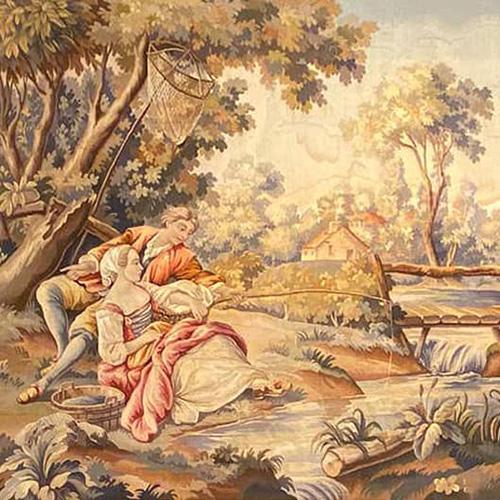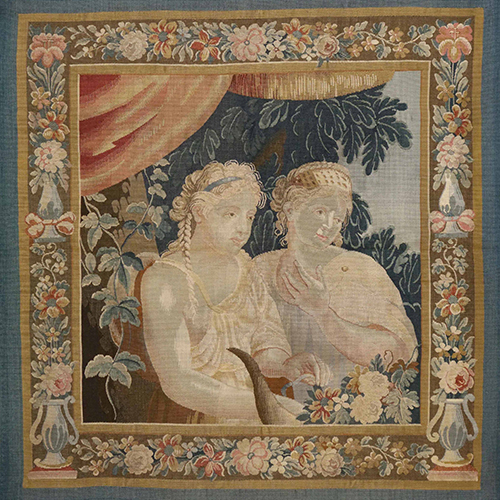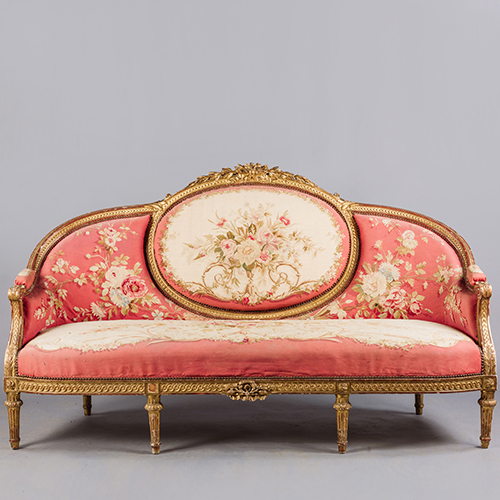

The picturesque town of Aubusson in central France is roughly equidistant between the historic cities of Clermont-Ferrand to the East and Limoges to the West, and is synonymous with the production of fine tapestry, rugs and carpets.
Local folk tales suggest the weaving trade was founded in the 8th century by Saracen soldiers following their defeat at the Battle of Tours. However, it is more likely that the skills arrived with Flemish settlers from the Dutch speaking regions of Northern Belgium.
Whichever version you prefer, the tapestry and rug trade in the town is thought to have originated in the early 14th century. The earliest examples would have been produced on looms based in family workshops but as Aubusson’s reputation grew, the cottage industry developed into a thriving trade.
As fine tapestries were extremely expensive to produce, Aubusson’s workshops catered almost exclusively for wealthy nobles, courtiers and the church. They were seen as status symbols with large bright wall hangings adding welcome heat and colour to draughty manor houses and monasteries.
Aubusson specialised in the production of verdure tapestries, works themed around flowers and foliage, which became immensely popular from the 16th century onwards.
 As weavers became more adept, designs evolved to incorporate pastoral or hunting scenes, with exotic birds perched amongst the flora and glimpses of far-off castles or towns. Designs were often taken from popular engravings or were hand-drawn to scale, providing the weavers with a template to trace.
As weavers became more adept, designs evolved to incorporate pastoral or hunting scenes, with exotic birds perched amongst the flora and glimpses of far-off castles or towns. Designs were often taken from popular engravings or were hand-drawn to scale, providing the weavers with a template to trace.
Aubusson achieved Royal recognition in 1665 when Jean-Baptiste Colbert (1619 – 1683), First Minister of State to Louis XIV, granted an official charter elevating the town's workshops to the status or Royal Manufactory.
At their peak it is said that the Aubusson workshops could rival the work of the great Gobelins Manufactory in Paris, and the equally esteemed Beauvais factory. However, success was sharply curtailed in the late 18th century as Revolution swept through France.
With the loss of the nobility, demand for fine tapestry dwindled, while the inventions of wallpaper and machine-made carpets also affected the market for fine woven wall hangings. Aubusson adapted to the changing taste by transferring much of its output to the creation of floral carpets and rugs.
The trade further adapted in the 19th century by creating woven tapestry coverings for use in the upholstering of furniture and as cushion coverings, making Aubusson’s distinctive designs even more integral to interior décor of the time.
 Aubusson tapestry continues to be produced using traditional methods in the town today. With three small businesses and around 10 freelance weavers still operating in the area. One notable recent example of the town’s work is Graham Sutherland’s, ‘Christ in Glory in the Tetramorph’, created for the consecration of the new Coventry Cathedral in 1962.
Aubusson tapestry continues to be produced using traditional methods in the town today. With three small businesses and around 10 freelance weavers still operating in the area. One notable recent example of the town’s work is Graham Sutherland’s, ‘Christ in Glory in the Tetramorph’, created for the consecration of the new Coventry Cathedral in 1962.
Measuring 75 ft by 39ft, the tapestry was produced in one single piece using an enormous 500-year-old loom and was, until recently, the largest tapestry ever recorded.
Perhaps the town’s greatest accolade came in 2009 when Aubusson Tapestry was added to UNESCO’s list of the Intangible Cultural Heritage of Humanity. A fitting tribute to more than six centuries of outstanding textile production.
Click here to view examples of Aubusson tapestry currently available from BADA members.

